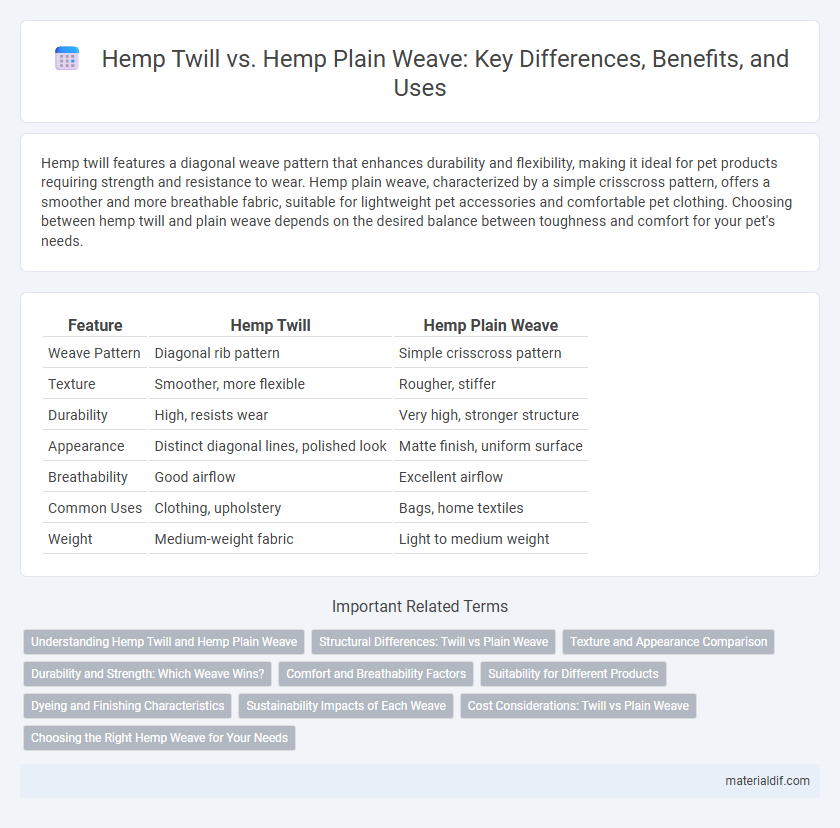Hemp twill features a diagonal weave pattern that enhances durability and flexibility, making it ideal for pet products requiring strength and resistance to wear. Hemp plain weave, characterized by a simple crisscross pattern, offers a smoother and more breathable fabric, suitable for lightweight pet accessories and comfortable pet clothing. Choosing between hemp twill and plain weave depends on the desired balance between toughness and comfort for your pet's needs.
Table of Comparison
| Feature | Hemp Twill | Hemp Plain Weave |
|---|---|---|
| Weave Pattern | Diagonal rib pattern | Simple crisscross pattern |
| Texture | Smoother, more flexible | Rougher, stiffer |
| Durability | High, resists wear | Very high, stronger structure |
| Appearance | Distinct diagonal lines, polished look | Matte finish, uniform surface |
| Breathability | Good airflow | Excellent airflow |
| Common Uses | Clothing, upholstery | Bags, home textiles |
| Weight | Medium-weight fabric | Light to medium weight |
Understanding Hemp Twill and Hemp Plain Weave
Hemp twill fabric features a distinctive diagonal rib pattern created by the weaving technique, resulting in increased durability and pliability compared to the standard hemp plain weave. Hemp plain weave is characterized by a simple over-under interlacing pattern, offering a balanced texture and breathability ideal for lightweight applications. Both weaves leverage hemp's natural strength and sustainability, but twill's structure enhances abrasion resistance, making it suitable for workwear and upholstery.
Structural Differences: Twill vs Plain Weave
Hemp twill fabric features a diagonal rib pattern created by weaving the weft thread over two or more warp threads, providing greater durability and a smoother texture compared to plain weave. Plain weave hemp fabric is made by interlacing warp and weft threads alternately, resulting in a simple crisscross pattern that offers a stiffer and more textured surface. These structural differences impact the material's flexibility, appearance, and suitability for different textile applications.
Texture and Appearance Comparison
Hemp twill features a diagonal weave pattern that gives the fabric a distinctive texture and a more structured, durable appearance compared to hemp plain weave. Plain weave hemp displays a simpler, uniform texture with a flat surface, resulting in a lighter, more breathable fabric. The twill weave's unique diagonal lines enhance visual depth and strength, making it ideal for sturdy garments, while plain weave is preferred for softer, lightweight applications.
Durability and Strength: Which Weave Wins?
Hemp twill weave offers greater durability and strength compared to hemp plain weave due to its distinctive diagonal pattern, which enhances resistance to abrasion and tearing. Plain weave, while simpler and more lightweight, lacks the structural reinforcement found in twill, making it less suitable for heavy-duty applications. For products requiring robust performance, hemp twill is the preferred choice for superior tensile strength and longevity.
Comfort and Breathability Factors
Hemp twill fabric offers enhanced durability and a smoother texture, making it more comfortable for extended wear compared to hemp plain weave. The diagonal pattern of hemp twill allows for better airflow, increasing breathability and moisture-wicking properties. In contrast, hemp plain weave is coarser and less flexible, reducing overall comfort and ventilation.
Suitability for Different Products
Hemp twill fabric features a diagonal weave pattern making it stronger and more abrasion-resistant, ideal for products requiring durability such as outerwear, bags, and upholstery. Hemp plain weave offers a tighter, simpler structure, providing breathability and a smoother texture suited for lightweight garments, shirts, and home textiles. Choosing between hemp twill and plain weave depends on the product's need for strength, texture, and breathability.
Dyeing and Finishing Characteristics
Hemp twill fabric exhibits a diagonal weave that enhances dye absorption, resulting in richer, more uniform color saturation compared to hemp plain weave, which has a simpler interlacing pattern that produces a more matte finish with less depth in color. The twill structure offers greater fabric durability and resistance to wear during dyeing and finishing processes, making it suitable for intensive treatments like enzyme washes and reactive dyes, while plain weave hemp tends to respond better to natural dyes and gentle finishing techniques due to its looser texture. Overall, hemp twill's tighter weave and structural integrity enable a broader spectrum of vibrant dyeing options and longer-lasting finishes, whereas hemp plain weave emphasizes softness and subtle coloration.
Sustainability Impacts of Each Weave
Hemp twill weave features a diagonal pattern that enhances fabric durability and abrasion resistance, making it long-lasting and reducing the frequency of replacement, which contributes to lower environmental impact over time. Hemp plain weave, characterized by its simple over-under pattern, requires less energy during production due to fewer weaving passes, thus minimizing carbon emissions and resource consumption. Both weaves benefit from hemp's natural resistance to pests and low water usage, but twill's extended lifespan can lead to greater sustainability in high-wear applications compared to the plain weave.
Cost Considerations: Twill vs Plain Weave
Hemp twill fabric generally incurs higher production costs due to its complex weaving pattern, requiring more time and skilled labor compared to the simpler plain weave. Plain weave hemp is more cost-effective, benefiting from faster manufacturing processes and less material waste. Choosing between twill and plain weave hemp often depends on budget constraints and desired fabric durability, with plain weave favored for affordable, lightweight applications and twill preferred for more robust, premium products.
Choosing the Right Hemp Weave for Your Needs
Hemp twill weave features a diagonal pattern that enhances fabric durability and drape, making it ideal for clothing and upholstery requiring strength and flexibility. Hemp plain weave offers a simple crisscross structure, resulting in a lightweight, breathable fabric preferred for summer apparel and eco-friendly home textiles. Selecting between hemp twill and plain weave depends on your need for ruggedness versus breathability, balancing functionality with aesthetic preference.
Hemp twill vs Hemp plain weave Infographic

 materialdif.com
materialdif.com